Mizoram is a state in northeastern India, with Aizawl as its capital city. The name is derived from “Mizo”, the name of the native inhabitants, and “Ram”, which means land, and thus Mizoram means “land of the Mizos”. The culture of Mizoram reflects the quintessential lifestyle and traditional heritage of the inhabitants of the Mizoram, popularly known as the ‘Songbird of the North east’. The people of Mizoram are collectively known as the Mizo. The textiles of Mizoram constitute one of the most significant art and crafts of the region. The textile industry of Mizoram offers a variety of garments, which are quite popular in the north-western part of the country of India. Many Mizo people are well known as skilled weavers. Weaving is one of the most important segments of the cultural life of the people of this state. The women are involved in weaving in Mizoram from a very early age.
Puan
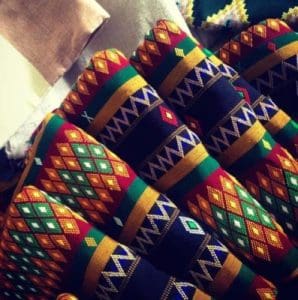
Paun: http://blog.directcreate.com/mizo-puan-weaving/
Puans are the traditional clothing of the native people of Mizoram. There are many kinds of Puans, and each colour, motif and design has a traditional and cultural significance to the Mizos. The weaving is done by women on the loin loom and the earnings empower them financially. Worn by both men and women, puan means cloth in the native language. Production clusters in Mizoram include Serchhip district (Thenzawl), and Aizawl district(Aizawl).
Woven predominantly on a loin loom, the puan is also occasionally woven on a frame loom or a Zo loom. The weaving in the loin loom is done in two parts, and the fabric is later stitched together. Frame handlooms produce single width fabrics.
The loin loom is very versatile in the sense that it supports a range of possibilities that can be woven. The weaver sits in front of the loom, fixes the back strap and rests her leg on the footrest. The footrest can be adjusted to keep the loom in tension. The weaving is done on the loom by a shedding motion, a picking motion, and a beating motion. The heald bar is lifted up with the left hand and the circular bamboo bar is pressed down with the right hand. The weft is then passed through from the right to the left by means of the shuttle, and is beaten by the sword. The shuttle is then passed from right to left, and the weft is again beaten. The one-up-one-down process of plain weave is repeated until weaving is complete.
The traditional way of wearing a puan is to wrap it around oneself from the waist to the ankle. The length of the puan is normally sixty to sixty-five inches. It takes a week or more to finish a plain puan, and a month or more for one with patterns, on a loin loom.
Puan Laisen is a traditional wedding, festival and dance costume, with a red horizontal section in the middle. The Puan Hruih has a white background with black stripes and is worn by both men and women. The Puandum is balck, while its edges are red. The Tawlhlopuan is black, with red, yellow and white strips, denoting bravery.
Patterns like ginger flower, stars, roses, tiger’s skin etc are traditional motifs and designs used in the weaving of Mizo puan. These motifs have a traditional and cultural significance to each tribe.
The Mizo Puan is considered the traditional clothing of the Mizo people. Now worn mostly by women, the skirts were the common clothing for both men and women.
The yarn for weaving was cotton earlier, and has now been slowly replaced by acrylic yarn for its durability and attractive finish. While loin loom was used traditionally, now frame looms, zo looms and fly shuttles are used to weave the puan.
Embroidery of Mizoram
The female folks are more inclined towards work and have raised the art of weaving through their skills and beautiful designs. There are many different types of attire having different kinds of needlework.

Puanchei: https://wovensouls.org/2015/01/26/a-glimpse-of-stunning-mizo-textiles-the-puanchei/
Dazzling with bright colors Puanchei has embroidery with artificial diamonds along its stripes also it has needle work and the embroidery showing arrowheads. Traditional designs consist of graceful Ngotekherh. Ngotekherh is generally a combination of pleasing colors which is common on sarongs as locally known as puan. It is made ready on loom.
Traditional Costumes of Mizoram
The traditional clothing of Mizoram looks like the outfits of other hill states of the North-Eastern India. With a full fledge of outfits and colorful designs, costumes of Mizoram are stimulating enough to attract so many people. They comprise ethnic heritage of the habitants.
- Costumes for Women of Mizoram
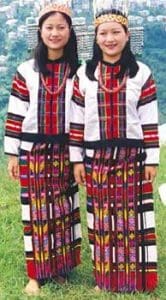
Paun: https://www.pinterest.ie/pin/7248049375903219/
Mizo women love to beautify themselves in Puan, which is the most favourite dress in Mizoram.Beautifully intricated design with perfect fit makes it the most preferred dress for the people of Mizoram.The lively color and the exceptional designs and fittings made this outfit superb. Puanchei is the beautiful costume of girls, mostly worn during festivals like Pawl Kut and Chapchar Kut.Its shades are white and black. The black shades of the attire is created from the synthetic fur.
- Traditional Costume of Mizoram for Women
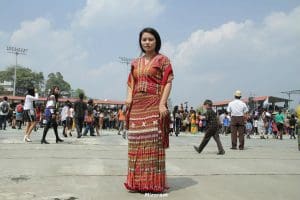
Kawrchei: https://twitter.com/ambshrivastava/status/958761348099465216
Another traditional dress worn by Mizo girls is known as Kawrechi.
Kawrchei is a magnificent blouse. It is made of cotton material and hand woven. It is a kind of handmade blouse, made up of cotton fabric and worn by Mizo women while dancing on festivals. It is generally paired up with Puanchei.
The cloths are designed from the cotton and hues are designed by “Ting’.
The traditional outfit of the women of the Lusei tribe is dark blue cotton skirt, worn round the waist and tightly held by a girdle or belt of brass wire. . Lusei girls wear a headgear . This is the dress, worn by all women, stretches itself up to the knees. This skirt is worn with a short white jacket and a cloth, wrapped in the same way as the males. Zakuolaisen is a beautiful piece of blouse with crimson stripes worn by unmarried females. And after marriage girls wear Puon Pie.
- Costumes for Men of Mizoram

Source: https://www.pinterest.com/pin/842032461558445639/
Men in Mizoram like to live a simple life. This also reflects in their traditional clothing. They dress up in a long piece of cloth, almost 7 feet long and 5 wide. During the winter season, additional clothing is draped like a coat which comes down from the throat enveloping till the thighs. Red and white colored coats are mostly preferred by the Mizo males.
During the summer months, they wear outfits around their waist to make themselves comfortable. Additionally, to prevent from the scorching sun, a Pagri or Turban is put on. The males of Lusei tribe consider only cotton made clothing, cultivated in the region itself.
- Traditional Costume of Mizoram for Men
There is no difference existing in the costumes of the ordinary Lusei and the head of the community. Only during festive occasions, the costume differs from one another.
Tribes in Mizoram
Although it can’t be accurately deduced, it is believed by the scholars and alike that the area of the present Mizoram was originally inhabited by the Mongoloid and other tribal groups who had migrated from China and other northern countries.

Tribes: https://www.indianetzone.com/8/tribes_mizoram.htm
The major parts of the population of Mizoram consist of the ethnic tribes and they are interlinked by means of cultural or linguistic origins. The tribal culture of Mizoram and these ethnic groups of people as a whole are known as Mizos (Mi means ‘people’ and Zo means ‘hill’). In majority the tribal people of Mizoram may be summed up into four kinds of tribal communities.
There is a striking similarity in the physical features of these groups of people. Moreover the tribes of Mizoram are simple, happy, literate, liberal, generous, hospitable and social by nature. They cherish the gift of friendship very well and like to live free.
- Chakma Tribe
There are around eighty thousand people in Mizoram that belong to the Chakma tribes which is the most important group in the area. Their language and diction is quite similar to that of Bengali. Besides the Chakma tribes, the other tribes are also significant as well. This tribe is mostly found in Southeastern hills in Mizoram. The Chakma tribes are divided into various clans.

Chakma tribe: https://www.indianetzone.com/8/chakma_tribe.htm
The Mizos are another important tribe in Mizoram. The villagers of this tribe reside on top of hills. This tribe is divided into five major and eleven minor sub-tribes. Cultivation is the major occupation of this tribe, ho practice the Jhum Cultivation. Apart from jhum cultivation they also cultivate cash crops, sugarcane and tobacco. Chapchar Kut and Pavlkut are the major festivals along with Creraw and Khullam are the most colourful dances of this state.
- Pawi Tribe

Pawi Tribe: https://in.pinterest.com/pin/298433912800069902/
The Pawi communities of Mizoram are mostly found in the south and southeastern part of this state. This tribe call themselves as Lai, who has migrated from Chin Hills of Burma. Lai are the people belonging to the Lai Autonomous District Council of Mizoram, North-East India and Hakha, Thantlang, and Falam of Chin State, Myanmar. Lai people can also be found outside their main dominant area. The Pawis are divided into various clans. They grow maize and millet. Their language is Lai language and speaks Mizo language.
- Dimasa Tribe
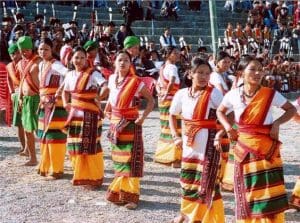
Dimasa-Kacharis: https://www.pinterest.com/pin/287245282457588494/
The Dimasas also called as Dimasa-Kacharis are one of the ancient kachari tribes in Mizoram. Now-a-days they mostly reside in Dima Hasao district of Assam. Bishu is the important festival of this tribe that celebrated after competitions of harvest. Apart from Bishu they also perform various rituals and dances
Art and Craft of Mizoram
There are various kinds of art and crafts in Miizoram, which form an important sector of the industrial market of the state. The main art and crafts of Mizoram are textiles, bamboo and cane works and basketry. The textile industry is one of the main art and crafts of Mizoram. Generally, the Mizo women are engaged in weaving which constitutes a major sector of Mizoram cultural life. The people of Mizoram produce a wide range of textile products.
- Basketry
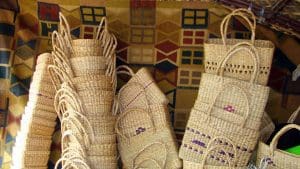
Baskets: https://www.camelcraft.com/mizoram-handicrafts.html
One of the well known industries associated with the art and crafts of north-western India is basketry in Mizoram. There are four major types of baskets created in Mizoram. These different types of baskets are given below. The closed-weave basket is a type of basket, which is generally used by the Lushais of the state. There are three types of baskets that fall under this type of baskets of Mizoram. These are tlamen, paiem and dawrawn. Tlamen is used for carrying agricultural products and dawrawn is used for storing as well as carrying purposes. Paiem is used for carrying various agricultural products and also for marketing.
The open-weave baskets are meant for carrying purposes. There again two different varieties of such baskets are found in Mizoram. These are the emsin and the paikawng. The paikawng is generally used by the people belonging to the Lushai ethnic group. It is used by the women for carrying a variety of items like water tubes made out of bamboo, firewood and many other articles of daily use. The emsin is actually a decorated paikawng. It is similar to the paikawng in structure. It is used for carrying different items to the fields and also for marketing.

Thul basket: http://mizopad.blogspot.com/2017/10/thul.html
Thul is a type of basket produced here which is meant only for storage. It has a lid and is ideal for storing various household items. Some baskets are specially meant for storage and are small in size. There are two types of such baskets in Mizora. These are the fawng-te-laivel and the fawng. Both these types of Mizoram baskets are similar in structure, but the fawng-te-laive is smaller in size and is used to store yarn.
- Ornaments
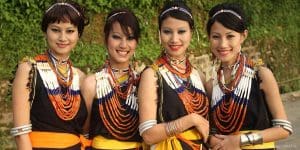
Ornaments: https://blog.saralmarriage.com/know-brides-wedding-dresses-mizoram/
The ornaments worn by men and women of Mizoram are considered an essential adornment and are in perfect contrast to their colourful dresses. Most Lushai men sport a variety of products in their hair. A two-pronged pin with a head-shaped g-skewers of ivory, metal and bone, is one of the most common items made in brass. Thifen, a small beaded necklace is also a popular ornament worn by different tribes of the region. Another popular jewellery item flaunted by the Mizo people is a necklace having large amber beads known as the thihus. Women wear a headgear decked with a bamboo band called varika, which sports colourful feathers and beetle wings.
- Bamboo and Cane Works

Bamboo work: https://www.tourmyindia.com/states/mizoram/art-and-crafts.html
Bamboo and cane works of Mizoram is one of the major art and crafts that are associated with this part of north-eastern India. The people of this state make a variety of beautiful and useful items out of cane and bamboo. Generally, the men are engaged in making the cane and bamboo crafts at Mizoram. This art form is so rampant in this region of the country that the Mizo people even make their houses with bamboo. The floors and walls of the houses are made up of bamboo.
There is a wide range of Bamboo and cane works of Mizoram. The various kinds of cane and bamboo products of Mizoram are produced at the three different centers of handicraft located in Lunglei, Aizwal and Chimptuipui. One of the most important bamboo and cane products of the region are hats made of cane. Different types of baskets are produced by the people of this state. The different kinds of baskets made in this region are meant for carrying or storing different household items.

Bamboo and cane work: https://www.indianetzone.com/41/bamboo_cane_crafts_mizoram.htm
Other bamboo items are animal and fish traps. The bamboo cones, japis and circular boxes are used for storage purposes. A wide range of jewelry that are worn by the Mizo people are made out of bamboo. One of the well known bamboo ornaments of Mizoram is a traditional headgear. The Mizoram cane and bamboo crafts play a significant role in the economy of the state. There is a substantial market of cane and bamboo products as these handmade ethnic items are much in demand among the tourists.
Reference
https://en.wikipedia.org/wiki/Mizoram
https://www.mapsofindia.com/mizoram/culture/
http://blog.directcreate.com/mizo-puan-weaving/
http://www.craftandartisans.com/embroidery-of-mizoram.html
http://traditionalclothingindia.blogspot.com/2013/10/traditional-costumes-of-mizoram-for-men.html
https://www.mizoramonline.in/about/profile/culture

Article Writtten By-
Ms. Sidrah Mubin Patel. B.Sc. in Textiles and Apparel Designing, Sir Vithaldas Thackersey College of Home Science.
Textile Value Chain Intern. Email: tvcmedia.digital@gmail.com

